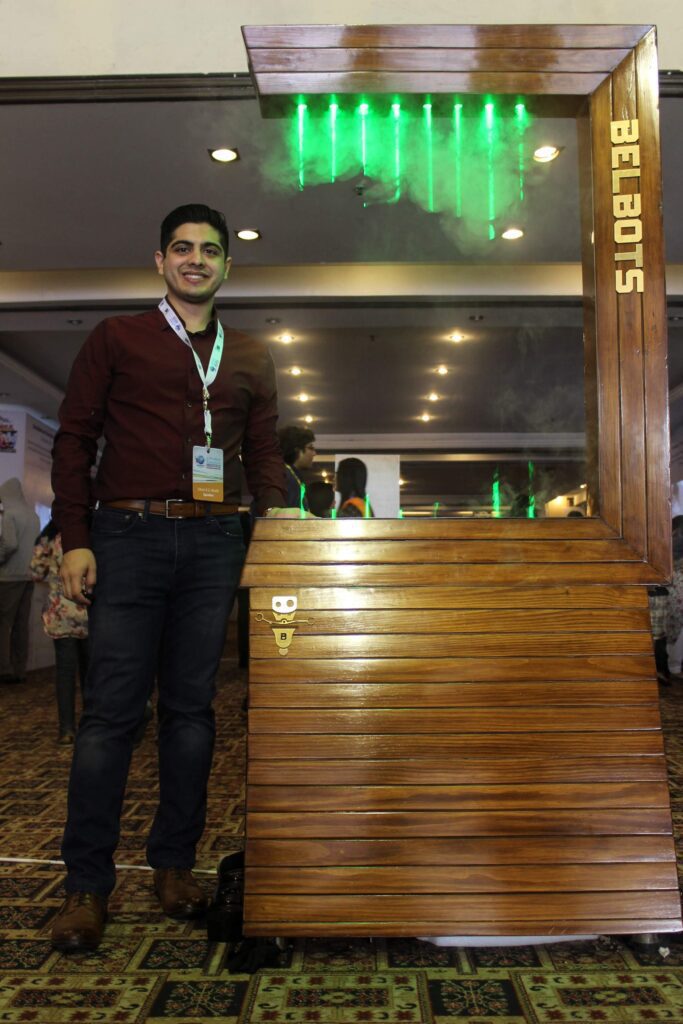Sibel Mufti is a Biomedical Engineer who has worked with artificial limbs, robotics education and founded a tech start-up in Pakistan that made the country’s first laser harp. He is fascinated by the future of human health and society, and how technology will help shape it. He resides in Canada.
As artists, we often tend to focus on the philosophical and artistic questions that a post-reality world instigates. With a background in biomedical engineering, however, Sibel Mufti brings a totally different perspective to the table. Sibel particularly focused on artificial limbs, where “the question that always comes up is what happens when we create an artificial limb that can surpass a human limb, when we start to integrate senses that humans aren’t born with.” He refers to the concept of biohacking and how some people inject tiny magnets into their fingers to be able to sense electromagnetic fields.
When Sibel was working on developing the first curriculum in robotics for Beaconhouse School System, (the largest ever such initiative in Pakistan at the time), he often ran into the question of why it was important for students to learn about these kinds of intelligent technologies and their medical technological integrations. He notes that “We are already surrounded by immersive intelligent technology that is gathering data and the only way for us to participate in the process of how these systems will develop and work is by understanding them. You cannot be an informed decision maker or even part of the narrative unless you know what’s going on.”
The future of technological integration
The subject of biohacking and technological integration with humans naturally raises some complicated questions, as they force us to wonder what is human. Biohacking is perhaps more audacious than biomedical engineering in that it bypasses safety assurance processes (that all drugs and devices undergo) and leverages human anatomy to be able to do whatever the user requires, but Sibel feels that they are essentially the same in attempting to mimic and enhance the human system.
Sibel eloquently explains the cognitive dissonance around the whole concept, saying “Every person and us as a species have an inherent need to believe that we are unique and we are complete as a species and as individuals,” but then pragmatically points out that “The reality is that you and I probably know people who have pacemakers.” He believes that in our group psychology, we continually shift the benchmark of what is intelligence. At the beginning, for example, he notes that automatic doors might have once been considered intelligent.
Overall, he believes that “Our integration with technology has already begun and we are past the point of no return – unless you want everyone with a pacemaker to die.” But while this integration might be inevitable, we can shape it, which is why “we need to be super careful about how all of this is used and the only way we can do that is by knowing what we’re talking about.”
Technology and Art: The Laser Harp

While he does not consider himself an artist, Sibel has his own sense of aesthetics and art. A few years ago, he headed a project to build a laser harp, something he’d always had the idea to do. The concept is simple: a laser is directed at a sensor. When you touch the laser beam it blocks the light, the sensor picks it up and sound comes out. Sibel remarks that the technology was simplistic, but the real achievement that he and his team accomplished was creating something that was both beautiful and wondrous. The intersensory experience of touching light and producing music is something that Sibel found magical. He and his team worked hard on the design and the aesthetics of the wood and steel, blending something very natural with the technology.
The laser harp is now on display at Sibel’s family house. Eventually, he hopes it will become a living art piece, but for the moment, having created it and brought a touch of magical beauty into the world is enough.
Winding up – bringing in post-reality
Finally, as with all the interviews in this series, we end by talking about post reality. On that note, Sibel explains, “I spend a lot of time in my head, in imagination. Before the era of social media I would spend plenty of time thinking about other people. When social media came about, that space was mostly occupied by what’s happening on social media. So the concept of post reality is more just giving form to the area of social daydreaming that humans have had for so long. My worry is, and something I’ve seen with kids growing up with it, is that their identities are being defined and they’re making decisions based on the figments of social media and the digital realm which doesn’t exist outside the realm of electronics – a few hours without power, and it’s all gone.”
